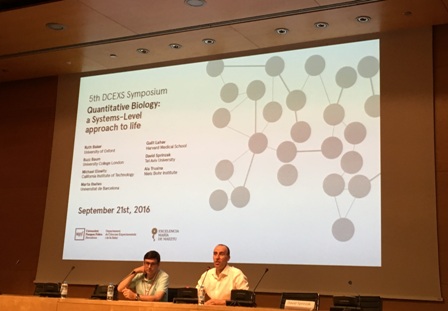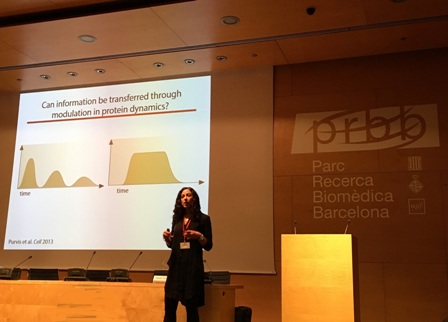Mathematical and computational models, increasingly present in biomedical research
Mathematical and computational models, increasingly present in biomedical research

On the occasion of the 5th Symposium of the Department of Experimental and Health Sciences, on 21 September, internationally renowned scientists gathered at the Barcelona Biomedical Research Park (PRBB) to share their knowledge on quantitative biology, a branch of research that uses mathematics and physics to understand the function of living cells and organisms in general.
"Over time it is becoming clear that just by looking at the parts that form a biological process, we will never know the whole process. To understand how complex biological systems work we use specific tools such as mathematical models". This is how Jordi G. Ojalvo, leader of the Dynamics of Biological Systems laboratory and organizer of the event together with the researcher at the Center for Genomic Regulation, James Sharpe, opened the 5th DCEXS Symposium. After the presentation by the director of the Department, David Comas, Ojalvo gave the floor to the seven guest speakers.
 A Symposium notable for the diversity of subjects
A Symposium notable for the diversity of subjects
Quantitative biology encompasses all research that combines quantitative experimental techniques and computational models to gain a greater insight into the interactions that take place between and within living beings. This wide range of possibilities explains the variety of subjects discussed in the lectures offered at the symposium.
Galit Lahav, principal investigator at the Department of Systems Biology at Harvard Medical School, gave the first lecture, entitled "Dynamics of cancer pathways in single cells". Lahav’s research focuses on p53, a tumour suppressor protein. In her talk, Lahav presented possible strategies based on the dynamics of the degradation of p53 as a cancer therapy. “The fact that p53 is mutated in 50% of cancers implies that in the remaining 50% it is not. What is the difference between one group and another?“ According to Lahav, the importance of p53 lies not only in its function, but also in its rate of degradation, which may be key in cancer treatment.
Under the title “The origins of eukaryotic cell organization”, the head of the Laboratory for Molecular Cell Biology at University College London, Buzz Baum, contributed an overview of the existing theories about the origins of cells, especially focusing on eukaryotes and their complex architecture. This conference, of an informative nature, extolled the knowledge gained by researchers in the past while emphasizing the lack of understanding of the origin and functioning of cells. “I believe we still don’t have the logical understanding of cells. It is not enough just to name of the organelles that form them in order to understand their functioning”.
“In many areas of science, progress comes by changing the point of view. In genetics, simply by changing the way we represent genetic circuits, we make a lot of progress“. The researcher of the Howard Hughes Medical Institute, Michael Elowitz, also drew attention to cell architecture, although his talk, entitled “Signaling, memory, and fate at the single-cell level”, addressed more specific aspects, such as the interaction between ligands and receptors, the regulation of gene expression and the possibilities that would be available in synthetic biology if we could control cell architecture. “If we could design synthetic systems that implement a complex development, we could create organs that grew by themselves autonomously”.
The programme was completed by the scientists Ruth Baker, University of Oxford; Marta Ibañes, University of Barcelona; David Sprinzak, University of Tel Aviv, and Ala Trusina, of the Niels Bohr Institute. The Symposium ended with the award for the best scientific poster, which went to Om Patange, researcher at the University of Cambridge.
This is the fifth consecutive year that the DCEXS has held its annual Symposium. This initiative seeks to present the department’s research programmes and promote the education of young scientists and provide a place where researchers can discuss and discuss their latest results.
